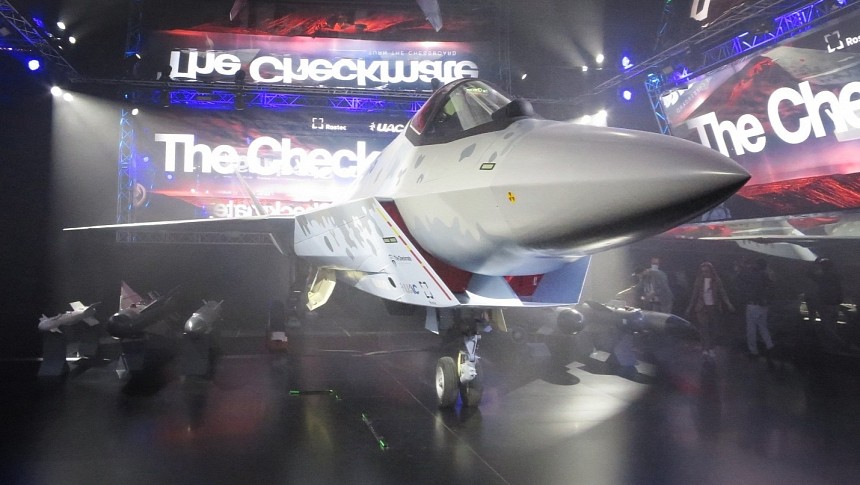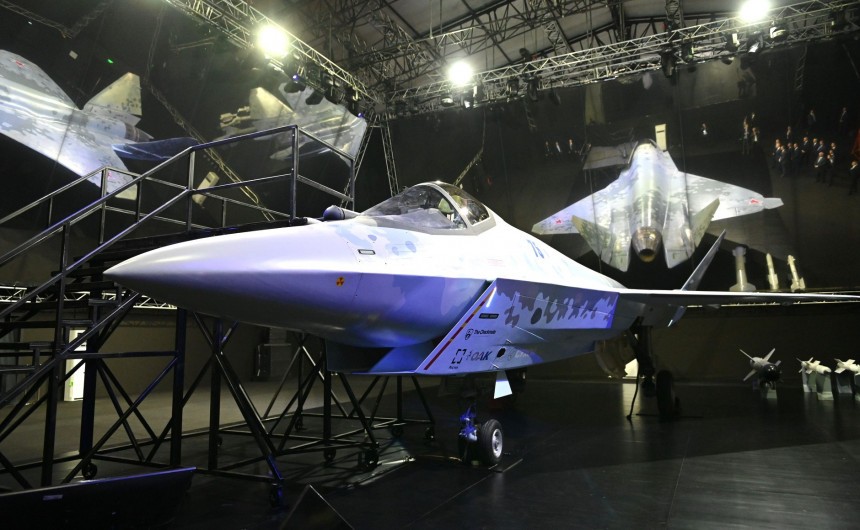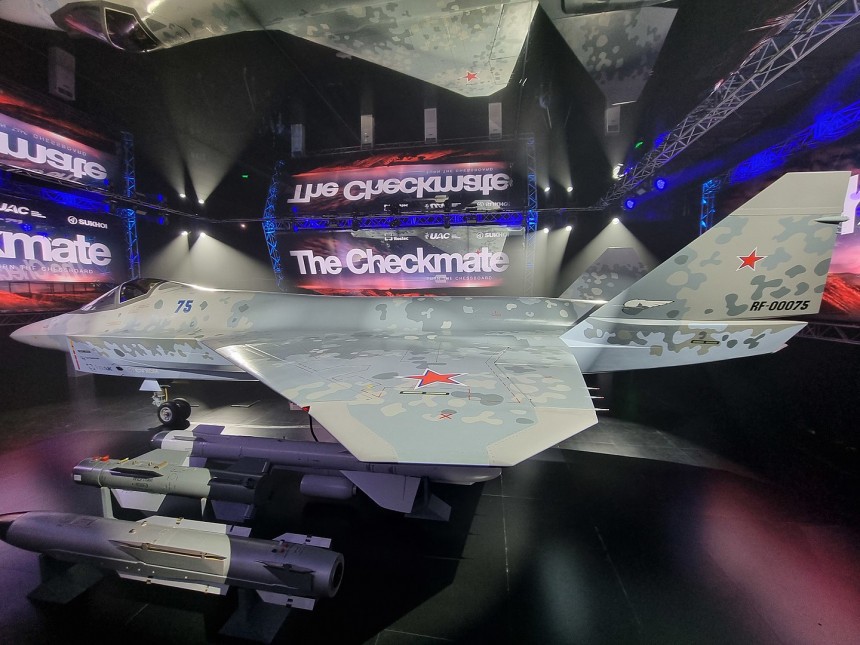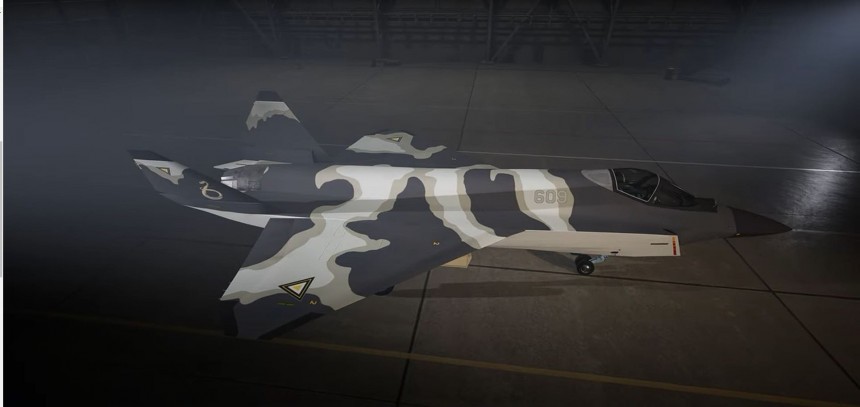If an oak tree in the Siberian forest falls and nobody's around to hear it, did it even happen? More to the point, if a prized Russian gen-V fighter jet designed to fight the F-35 fails to make its first flight for another calendar year, should NATO be any more indifferent? This is the eternal dilemma unfolding in the saga of the Sukhoi Su-75, Putin's single-engine stealth fighter stuck in development purgatory.
A good fifth-generation, single-engine stealth jet fighter is a mark of an elite global air force these days. As soon as the Pentagon selected the Lockheed Martin F-35 Lightning II for NATO's Joint Strike Fighter program in the early 2000s, the Russian Air Force, now the Russian Aerospace Forces, knew this to be true. But there was a problem; anyone who knew anything about the Russian Federation in the 20 years after communism knew Russia and its rubles were soon parted. That's a real conundrum if trillion-dollar stealth fighter programs are the name of the game.
Soon after the production-variant of the F-35's first flight in December 2006, the Russian Ministry of Defense employed the historic Sukhoi Design Bureau to develop a Russian equivalent for their own Air Force. Sukhoi, though not nearly as financially endowed as European, Asian, or American aerospace companies, did at least have the benefit of co-developing the new jet with Sukhoi's answer to the F-22, the T-50, which the company had been hard at work with since at least 2002. Today, we know the T-50 as the Su-57 (NATO Codename: Felon).
Only a significant degree of overlap in personnel, construction materials, and general flight systems between the T-50 and what came to be called the T-75 prevented the latter program from being financially out of reach for Vladimir Putin's government. In the end, a relaxed, budget-friendly development schedule ensured it'd take until 2021 for the Su-75's final design mockup. It was displayed at the International Aviation and Space Show (MAKS) at Zhukovsky International Airport in Moscow. On first impressions alone, it was almost impossible not to draw comparisons between Sukhoi's new jet fighter and the American F-35.
With dimensions of roughly 17.5 m (57.4 ft) long and an 11.8 m (38.7 ft) wingspan, the Su-75's measurements are only slightly larger than the American Lightning II. Though official curb weight measurements aren't yet available to Western media, it's not unreasonable to assume the Su-75 will weigh in the same ballpark as a fully-loaded F-35A, or around 65,918 lbs (29,900 kg).
With a trademark diverterless supersonic inlet under the nose, a la like an F-16, and an aggressive-looking V-shaped tail, the Su-75 sports a somewhat unique appearance by gen-V stealth fighter standards. Restriction on what types of airframes can maintain radar stealth has led most contemporary fifth-gen fighters to look like carbon copies of the F-22 or the F-35. Of course, fifth-gen fighters are designed to never have to visually encounter enemy aircraft up close in the first place.
Though exact engine specifications for the Su-75's engines have yet to be confirmed, the consensus among Western analysts appears to suggest the novel Saturn izdeliye 30 afterburning twin-shaft turbojet engine that's also set to power the upgraded Su-57M. Being almost a third lighter by weight than the Saturn AL-41F1 that powered the Su-27, this engine is estimated to produce 171.7 kN (38,600 lbs) of thrust at full afterburner, or roughly 4,400 lbs less than the Pratt & Whitney F135-PW-100 that powers the F-35.
Inside the Su-75's cockpit, the same fully glass LCD cockpit from the Su-57 is expected to be a prominent feature. Using an advanced heads-up-display helmet and multiple multi-function displays to integrate all the aircraft's weapons, flight controls, radar, avionics, and life support subsystems into easy-to-use touch screens could be a game-changer for Russian pilots, as it's been for newer western aircraft. Through these cockpit displays, Su-75 pilots will be able to toggle between a plethora of different weapons from Vympel air-to-air missiles ranging from short to very-long-range, air-to-ground missiles, plus anti-radiation and anti-ship missiles, aside from the obligatory as-yet unannounced autocannon. -
It all looks fantastic on paper, something that seems genuinely capable of taking on squadrons of F-35s with over-the-horizon missile attacks. Should beyond-visual-range combat be unsuccessful, the question of which jet would win in a dogfight is one that'll likely come down to pilot skill more than anything, a bit like great dogfights of old. But, this being Russia in 2023, things are a lot more complicated than some statistics from Kremlin-moderated press releases.
As a result of the ongoing Russian invasion of Ukraine, Vladimir Putin's war machine might not have microchips to manufacture any gen-V fighters, let alone two bespoke airframes. For the last 14 months, the United States Department of the Treasury has barred the Russian Federation from trading for goods in U.S. Dollars, on top of billions in sanctions by NATO member states and their allies.
As a result, Russia simply can't afford to risk losing currently-operational next-gen hardware like the Su-57 but also the T-14 Armata main battle tank.As of May 2023, Western intelligence knows of only 21 Su-57s confirmed to have been manufactured, ten test aircraft, and 11 operational fighters.
The partial Kremlin state asset United Aircraft Corporation, license builders of the Su-57, have agreed to build four test articles of the Su-75. But all the while, the projected date for the Su-75's inaugural test flight has slipped from sometime in 2023 to 2024.
This brings the NATO Codename "Checkmate's" estimated introduction in 2027 very much into question. Depending on the results of the Russo-Ukrainian war, who even knows if the Russian Federation will survive to see the Su-75's operational deployment. Four years is a long time for such tomfoolery to take place.
By the same token, over 1000 F-35 Joint Strike Fighters have been manufactured as of 2023. Yeah, there's some considerable ground to make up. But what do you think? Will the Su-75 even make it off the ground at all? Or is it destined to only ever take flight in the next Ace Combat game? Let us know in the comments down below. Bonus points if you predict the thing winds up not even being stealthy and turn out being right.
Soon after the production-variant of the F-35's first flight in December 2006, the Russian Ministry of Defense employed the historic Sukhoi Design Bureau to develop a Russian equivalent for their own Air Force. Sukhoi, though not nearly as financially endowed as European, Asian, or American aerospace companies, did at least have the benefit of co-developing the new jet with Sukhoi's answer to the F-22, the T-50, which the company had been hard at work with since at least 2002. Today, we know the T-50 as the Su-57 (NATO Codename: Felon).
Only a significant degree of overlap in personnel, construction materials, and general flight systems between the T-50 and what came to be called the T-75 prevented the latter program from being financially out of reach for Vladimir Putin's government. In the end, a relaxed, budget-friendly development schedule ensured it'd take until 2021 for the Su-75's final design mockup. It was displayed at the International Aviation and Space Show (MAKS) at Zhukovsky International Airport in Moscow. On first impressions alone, it was almost impossible not to draw comparisons between Sukhoi's new jet fighter and the American F-35.
With dimensions of roughly 17.5 m (57.4 ft) long and an 11.8 m (38.7 ft) wingspan, the Su-75's measurements are only slightly larger than the American Lightning II. Though official curb weight measurements aren't yet available to Western media, it's not unreasonable to assume the Su-75 will weigh in the same ballpark as a fully-loaded F-35A, or around 65,918 lbs (29,900 kg).
Though exact engine specifications for the Su-75's engines have yet to be confirmed, the consensus among Western analysts appears to suggest the novel Saturn izdeliye 30 afterburning twin-shaft turbojet engine that's also set to power the upgraded Su-57M. Being almost a third lighter by weight than the Saturn AL-41F1 that powered the Su-27, this engine is estimated to produce 171.7 kN (38,600 lbs) of thrust at full afterburner, or roughly 4,400 lbs less than the Pratt & Whitney F135-PW-100 that powers the F-35.
Inside the Su-75's cockpit, the same fully glass LCD cockpit from the Su-57 is expected to be a prominent feature. Using an advanced heads-up-display helmet and multiple multi-function displays to integrate all the aircraft's weapons, flight controls, radar, avionics, and life support subsystems into easy-to-use touch screens could be a game-changer for Russian pilots, as it's been for newer western aircraft. Through these cockpit displays, Su-75 pilots will be able to toggle between a plethora of different weapons from Vympel air-to-air missiles ranging from short to very-long-range, air-to-ground missiles, plus anti-radiation and anti-ship missiles, aside from the obligatory as-yet unannounced autocannon. -
It all looks fantastic on paper, something that seems genuinely capable of taking on squadrons of F-35s with over-the-horizon missile attacks. Should beyond-visual-range combat be unsuccessful, the question of which jet would win in a dogfight is one that'll likely come down to pilot skill more than anything, a bit like great dogfights of old. But, this being Russia in 2023, things are a lot more complicated than some statistics from Kremlin-moderated press releases.
As a result, Russia simply can't afford to risk losing currently-operational next-gen hardware like the Su-57 but also the T-14 Armata main battle tank.As of May 2023, Western intelligence knows of only 21 Su-57s confirmed to have been manufactured, ten test aircraft, and 11 operational fighters.
The partial Kremlin state asset United Aircraft Corporation, license builders of the Su-57, have agreed to build four test articles of the Su-75. But all the while, the projected date for the Su-75's inaugural test flight has slipped from sometime in 2023 to 2024.
This brings the NATO Codename "Checkmate's" estimated introduction in 2027 very much into question. Depending on the results of the Russo-Ukrainian war, who even knows if the Russian Federation will survive to see the Su-75's operational deployment. Four years is a long time for such tomfoolery to take place.












